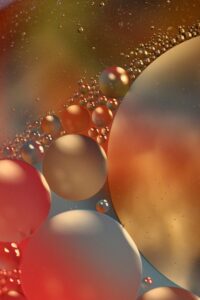Perrin needed to prove that NA is a constant in the following equation that he had derived:
The problem was that N’, N and m could not be measured directly. He circumvented the problem by replacing the gas in the cylinder with visible particles suspended in a liquid. Drawing from the principles of Brownian motion, Perrin assumed that collisions between liquid molecules and the visible particles would result in the particles being distributed in the same way as gas molecules were distributed in the cylinder. He also assumed that the motion of the particles obeyed the ideal gas law.

Perrin used a monodisperse colloid of a gum called gamboge comprising thousands of gamboge spheres in a water cylinder. He studied the distribution of the spheres with a microscope and made an adjustment to eq9, taking into account the upthrust by water on the gamboge spheres. For a single gamboge sphere (“particle”),
upthrust = weight of liquid displaced = ml g = dVl g (10)
where ml is the mass of the liquid displaced, d is the density of the liquid and Vl is the volume of the liquid displaced. Furthermore, the volume of liquid displaced is equal to the volume of the particle, Vp :
Vl = Vp (11)
Substitute eq11 in eq10,
upthrust = dVp g (12)
Since Vp = m/D, where m is the mass of a particle and D is the density of the particle, eq 12 becomes:
The effective weight of the particle is therefore the difference between the weight of the particle and the upthrust on the particle:
Substituting the weight of a gas molecule in eq9, mg, with the effective weight of a suspended particle, we have:
The suspended particles must be heavier than the liquid molecules for the particles to push down on the liquid molecules to produce an upthrust, resulting in the particles having a lower effective weight. This means that d < D for eq14 to be valid. Hence, the choice of particle material is important.

Perrin meticulously prepared emulsions containing particles that were equal in size. He calculated the average mass of a particle by weighing a specified number of particles, determined its density in different ways (including the specific gravity bottle method) and counted the number of suspended particles per unit volume at various heights using a microscope.
After repeating the experiment with different particle material (e.g. mastic), sizes, masses, liquids and temperatures, he found that the value of NA remained fairly constant and reported numbers ranging from 6.5 x 1023 to 7.2 x 1023. He further conducted experiments using methods based on radioactivity, blackbody radiation and the motion of ions in liquids and obtained very similar results for the value of NA. Perrin concluded that the results justified the hypotheses that had guided him, including Avogadro’s law, and named the constant the Avogadro constant, in honour of Avogadro.
The accuracy of the value of the Avogadro constant was subsequently improved by other scientists, one of whom is Robert Millikan.
